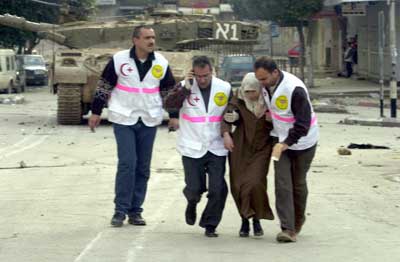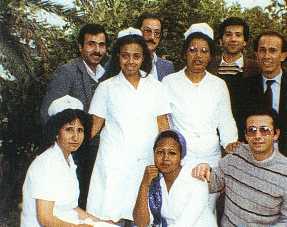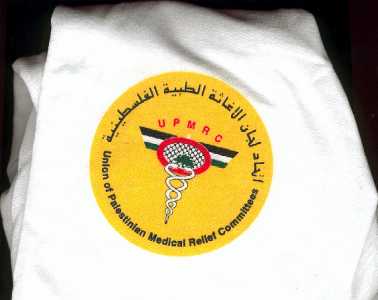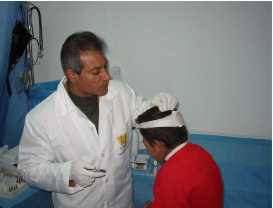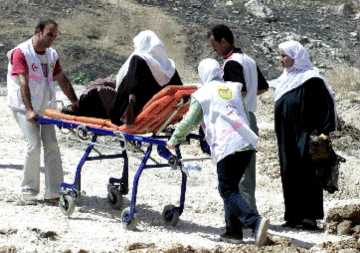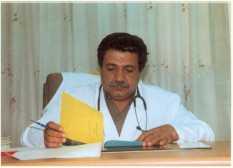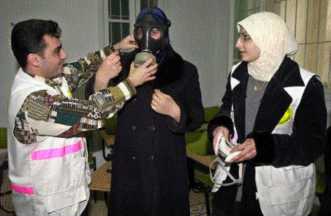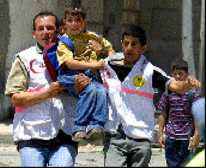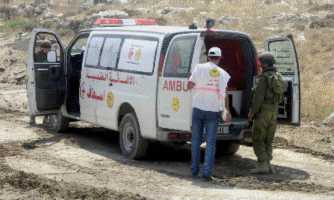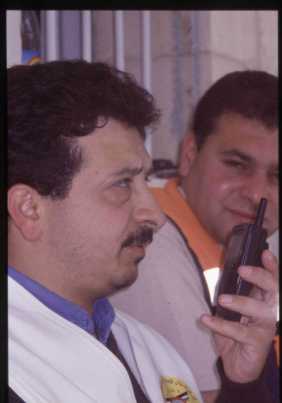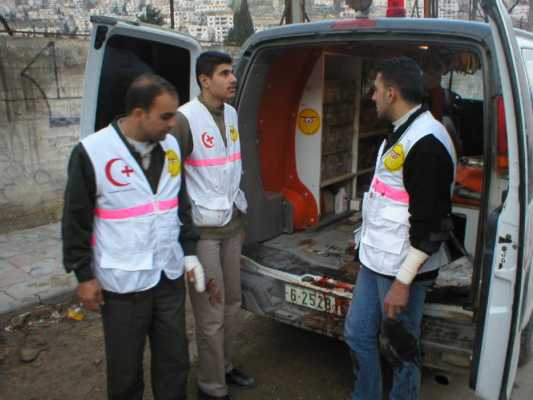Striving for peace.
Welcome to the Soap Factory |
 |
|
|
The birds are flying in the Palestinian sky above Jacobs Well of biblical fame. The well is situated just above the Balata Refuge Camp on the outskirts of Nablus. Last time I visited Balata Camp it was blocked off from Jacobs Well and Nablus by road blocks. Two belltower's have been constructed on the foundations above the entrance of the church since I took this photo. All things change and the story of UPMRC below shows how that change could be positive with our support. See the end of this history for how you can make contributions
The History of UPMRC.
The beginning.
Events leading to the foundation of Medical Relief - what is today known as the Union of Palestinian Medical Relief Committees (UPMRC) - began with Israel's invasion of the West Bank and Gaza Strip in June 1967. Prior to this event, the West Bank was under the auspices of the Jordanian government and the Gaza Strip under that of Egypt. The 1967 war marked the beginning of the Israeli occupation of the territories and its illegal annexation of Jerusalem. The event dramatically changed the lives and mindset of people throughout the Middle East and Palestinians everywhere.
For the next decade, Palestinians turned their eyes outward for rescue.
Slowly the realization grew among Palestinians in the Occupied Territories that little help would come from abroad, and they would have to take responsibility for their fate. From this realization, a spirit of volunteerism began to emerge during the mid-70s, and communities began helping each other. "If a person had a piece of land, we would help him farm it. If the streets needed cleaning or a house needed to be built, we would all pitch in," recalls UPMRC General Director Dr. Jihad Mash'al.
The Occupation's impact on Health Care.
Faced with continued military law, Palestinians in the Occupied Territories were forced to become increasingly self-reliant. Volunteer organizations therefore became an important means of rebuilding a Palestinian infrastructure that had been actively dismantled through Israeli policies. They provided services that were either non-existent or severely maligned under the Israeli law. More importantly, such services were provided by Palestinians for Palestinians, and the people did not have to rely on Israel for their basic needs. This movement proved a positive means of resisting the occupation and promoting steadfastness of the population.
Within the field of health care, in particular, a great need existed. During the occupation, the Israeli administration did much to undermine health care within the Occupied Territories. Much of this was due to neglect in the form of under funding. For example, in 1975, the Israeli health budget for the entire West Bank was equivalent to only 60% of the typical budget for one 260-bed hospital in Israel. Between 1967 and 1984 the number of hospital beds in the Occupied Territories actually decreased while the population doubled.
Israeli Measures.
The Israelis also took active measures to cripple and try to destroy health institutions in Palestine. They heavily taxed health establishments, closed professional unions, and hampered the ability of health practitioners to perform their jobs in needed areas. Israeli authorities also denied Palestinian health institutions permits to expand existing facilities, or build new ones. As a result, much of the Palestinian public health care infrastructure suffered. Palestinians were forced to become dependent on the Israeli system, which was controlled by the military authority and often used as a political tool to maintain control and order in the Territories.
With the public sphere under Israeli control, Palestinians could turn only to the private sector. Unfortunately, the private sector geared itself towards a biomedical, curative approach, and concentrated almost entirely on the larger urban areas of the Territories. Many rural and isolated communities lacked services of any kind, and treatment in general did not take other, non-medical factors into account when addressing health issues.
A Movement is Born.
Under these conditions, a group of Palestinian doctors working in Jerusalem hospitals, primarily Augusta Victoria, St. Joseph's, and al-Maqassed, came together in 1979 to address the needs of the underprivileged, and particularly rural, Palestinians. Although politically active, they felt that they could do more to resist the occupation than participate in demonstrations. They wanted to employ their talents and professional abilities in the service of their country.
These doctors, nurses and laboratory technicians began to organize mobile clinics on their free days. Using medication donated by the hospitals and local pharmaceutical companies, they would travel in their own vehicles to areas in need of support throughout the West Bank. The first such clinic took place in Deheisha Refugee Camp just south of Bethlehem. Areas such as the Jordan Valley and the Hebron and Ramallah districts soon followed. As they moved through the region, the influence of the mobile clinics grew. More communities heard of the activities and requested services. In 1980, "Medical Relief" was able to treat over 2,000 persons through its volunteer work.
Even at this early stage, the goal of Medical Relief entailed more than providing immediate care. The activities also included fostering community participation and mobilizing communities to help themselves. Thus, mobile clinics were often coordinated with other local committees, such as student, labor, and women's groups. All of these groups worked to unite volunteers from different fields in political support against the occupation and its practices.
Medical Relief further developed this community mobilization, as it still does today, through direct contact with the localities. Although the doctors of Medical Relief all worked in Jerusalem, they hailed from different areas in the West Bank, such as Ramallah, Hebron, Bethlehem, and Nablus. During their visits to these areas, they would enlist the aid of their colleagues and health facilities in the area. The people in each locality were encouraged to organize themselves and contribute to the service of their community. This assistance took hold and developed into the formation of large volunteer groups. Eventually, these groups formed different "committees", with active persons overseeing and coordinating the committee's efforts and activities.
Through its relationships in these areas, as well as in an expanding number of communities, Medical Relief came into contact and developed relationships with community leaders and the local structures. Work with women's committees and groups became increasingly important, and activities grew to include health education and literacy training.
Yet even while Medical Relief's activity spread, it still lacked proper financial or administrative support. For the first years, the committees still operated only on days when the volunteer health professionals did not have work, using their own transportation and donated medication and supplies, which were stored in their homes when not in use. And as the different area committees grew --some to include over one hundred volunteers -- it was clear that additional organization was required if the doctors and health practitioners of Medical Relief were to coordinate and expand their activities.
The initial year also brought the realization that a new form of health care was needed to respond to the needs of the underprivileged and financially needy; a system that would be able to comprehensively address the needs of Palestinian communities within the context of the continuing occupation.
Medical Relief began not as an organization, but as a mobile clinic in 1979, on a day of solidarity to help a city in need. That day, like the more than twenty years to follow, was anything but what we had expected.
The first mobile clinic.
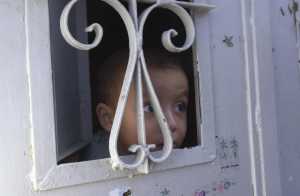
|
In April 1979, the Israeli army put the West Bank city of Hebron under a strict curfew, not allowing people to leave their houses except for a few hours each day for necessities. People were also denied access to either enter or exit the city. This collective punishment continued for over a month with the entire city under house arrest. Such conditions, particularly over such an extensive period, have severe ramifications on the health of the population. Closures and curfews mean that residents are unable to leave their homes to receive health care. If they do manage to get to hospitals and clinics, they often find them severely understaffed, as most of the employees living outside of the curfew area are denied permission to reach their workplace. Facilities are also under supplied, as new stocks of medicines and supplies cannot pass through the military blockade.
Out of a sense of solidarity and compassion towards the people of Hebron, a group of doctors from Jerusalem mainly from Al-Maqassad Hospital took the initiative to organize a humanitarian relief effort for the town under siege. Early one Friday morning, twenty doctors and nurses gathered medications donated from local pharmacies into their cars and began their mission to Hebron.
"We faced serious opposition from the medical establishment at the time," remembers Dr. Mustafa Barghouthi, one of the members of the mission and President of UPMRC, "The idea of a mobile clinic was new, and they thought that we were cheapening medicine. Seeing us carrying our bags, they called us 'barbers'."
The challenges facing them did not come solely from the Palestinian establishment. As they drove south towards the city, the group knew that they would confront opposition from the Israeli army. They were unprepared, however, for the lengths at which the military would go to prevent them from entering Hebron. "We tried everything," explains Dr. Mustafa, "but they would not let us in."
The group had to decide their next course of action, as the siege of Hebron was impregnable. "We felt a strong spirit of dignity and integrity as health professionals," Dr. Mustafa remembers, "We were in the right. Unlike the military, we were providing something positive. We could not just turn around and go home."
"It was a great learning experience for me," he continues, "When you encounter oppression, you should never accept defeat. it should challenge you to respond and act accordingly."
The group was determined to continue. They decided to take their medical specialties and medication to Deheisha Refugee Camp, located between Hebron and Jerusalem. One of the doctors in the group was from that region and knew that the residents of the camp also suffered from oppressive Israeli policies, faced serious health problems
as a consequence, and were in need of assistance. Upon arriving to the camp, they announced over the mosque loudspeakers that they were doctors and health workers who had come to bring medical services.
The response was overwhelming. Hundreds of people flooded into the streets, welcoming the health workers to the camp and thanking them for their efforts. People cleared out their houses to use as makeshift clinics.
"We were just shocked at the openness and generosity of the people. We had not expected such a welcoming," Dr. Mustafa fondly remembers.
The enthusiasm of the reception turned quickly into a spirit of hard work as the group of health professionals treated over 260 people in the refugee camp that day. They provided services such as general care, surgical consultations, and pediatrics. Dr. Mustafa notes that the treatment offered "was a shock to the people of the camp. This was something entirely different -- doctors bringing the services to them."
Despite the initial setback at Hebron, the day proved a resounding success. The warm reception and the great need for the services provided quickly convinced the members that they should continue operating mobile clinics. it was obvious that in order to begin improving the health status of the Palestinian people, they would have to provide more than a one-time humanitarian mission. The group decided to begin running mobile clinics more often. In order to achieve this end, the health professionals from that day formed Palestine's first "medical relief committee".
Medical Relief.
By the early eighties, nine different committees existed within Medical Relief. These operated in the areas of Jerusalem, the Jordan Valley, Ramallah, Nablus, Hebron, Bethlehem, Gaza, Tulkarem / Qalqilya, and Jenin. In order to coordinate the activities of these areas, and the hundreds of doctors located therein, it became necessary to join them under one Union. In 1983, the different branches of Medical Relief linked, and the Union of Palestinian Medical Relief Committees (UPMRC) officially came into existence.
As an organization, UPMRC began to build the necessary administrative and financial support for its activities, receiving its first official funding in 1983. However, it was not until 1987 that the organization rented its first office space in the Sheikh Jarrah neighborhood of Jerusalem.
Despite this process of institutionalization, the different committees retained much of their influence and autonomy. A democratic system was developed whereby each committee, often with one hundred or more members from the local communities, would elect a local executive committee to oversee activities in their region. These executive committees would then select representatives to the central board, many of whom sat on the organization's secretariat.
Linking the different committees allowed UPMRC to plan an effective overall strategy for its activities. Through their work with the communities, it became clear that more was needed than immediate relief care and treatment. Mobile clinics had been an important means of providing necessary medical care to underprivileged and rural Palestinian communities, but the situation necessitated a fundamental structural change as well.
Israel's illegal military activities continued in 1982, when the Israeli army advanced into Lebanon and occupied almost 10% of its northern neighbor's territory. Within the; Palestinian Occupied Territories, the Israeli military continued its callous rule. Mean while, more and more Palestinian land was being confiscated for the construction of Israeli settlements.
During the middle 1980s, the Israeli authority began aggressively suppressing the rising structure of services provided by Palestinian non-governmental organizations. The effects of the occupation and the continuous destruction of Palestinian services began to take their toll. In 1985, the infant mortality rate in Israel was 14 per 1,000 live births, 60 per 1,000 in Syria, and 55 per 1,000 in Jordan. That same year in the West Bank and Gaza, under what was supposed to be the same Israeli system, Palestinian infant mortality was 70 per 1,000 live births. Low physician-to-population ratio (8 per 10,000 in the Occupied Territories compared to 28 per 10,000 in Israel during 1986) contributed to the high mortality rate. The lack of physicians was accentuated by the fact that services provided were mostly biomedical in nature, and did not address the many social and political factors affecting the health of Palestinians.
Confronting these issues meant taking a closer look at the health care infrastructure in Palestine, and particularly its relationship to the occupation. While charitable organizations provided important and needed services, they were not willing to challenge the greatest obstacle to health in the country, the military occupation. The establishment of an effective, independent Palestinian health care system was essential-one that could not only address the needs of the people, but also resist the pressures and injustices of the occupation.
In order to respond to these health conditions in Palestine, UPMRC shifted its focus from relief care to primary health care. It concentrated more on preempting health problems through preventive and promotive activities rather than only addressing them through curative measures. Such work required the long term planning and coordination that the new Union provided, as well as working with community contacts to establish a permanent presence within the localities.
Addressing the systematic problems affecting Palestinian health required full-time attention. Although the number of volunteers was growing, efforts to further develop UPMRC's goals meant hiring permanent employees. So in 1984, UPMRC hired its first full-time staff to help connect and coordinate the various committees and their activities. In years to follow, UPMRC would continue to hire more permanent staff, but the emphasis on volunteers and volunteerism remains to this day. Even now, all employees at UPMRC donate a portion of their free time towards helping the organization and its activities.
The activities of the organization also reflected this move towards institutionalization. While the use of mobile clinics remained important, the organization's new staff began providing more activities on a permanent basis. This meant establishing primary health care centers and developing comprehensive health care programs.
UPMRC's first permanent health care center was established in 1984 in the Jordan Valley village of Dyuk situated just west of Jericho. Other centers soon opened in the villages of al-Oja, also in the Jordan Valley, Ithna near Hebron, and Tubas, located near Jenin in the northern part of the West Bank. Through its numerous mobile clinics, UPMRC members were able to establish strong contacts with the villages and determine which of these had the greatest need for a health care center. Often these clinics were established in areas having no other health care facilities. They offered general practice services and addressed the specific needs of the individual community.
Soon after the development of permanent health care centers, UPMRC began to expand its basic services by developing health programs. The first of these programs was General Practice. Shortly thereafter, UPMRC began to take a holistic approach towards issues such as women and children's health. The organization supplemented its basic clinical treatment with health education and training to enhance the health conditions of these and other issues. Although they generally worked out of the clinics, the programs introduced the different health professionals and beneficiaries to the long term, broader concepts central to primary health care.
As with the early mobile clinics, the development of health care centers sought to provide opportunities for and closely involve the communities they aided. Rather than remaining on the receiving end, community members were asked to take a more active role in their own development. This often meant using community members to provide the services for their own localities. Thus, health workers, especially the new Community Health Workers, generally came from and lived in the villages where they worked. Personal contact allowed for a greater understanding of the needs of the community, as well as a reciprocal openness to change.
UPMRC and other Palestinian development organizations provided the social, economic and health infrastructure for the Occupied Territories during the 80's. During this period, they were able to overcome a strong Israeli campaign against organized Palestinian development. Through such self-reliance and resistance, Palestinians began to feel a sense of unity and build a vibrant civil society.
This unity and cooperation would be further tested in the years to come, and political factors would again spark a change in UPMRC's priorities and activities. instead of waiting for outside help, however, the impetus for action came from within Palestine.
Intifada.
During the mid-1980s, a slow and steady movement in opposition to the occupation began brewing throughout the Gaza Strip and the West Bank. The Palestinian people could no longer wait for outside help to arrive. The collective frustration of twenty years of Israeli occupation reached its boiling point on December 9, 1987, when an auto accident between an Israeli truck and two Palestinian vans sparked a national uprising. The intifada (Arabic for "uprising") proved to be a major turning point in the Palestinian-Israeli conflict. The Palestinian people took to the streets in demonstrations, strikes and riots and became symbols of resistance to years of oppression and occupation. With the Palestinian public united for the first time in 40 years, since the establishment of Israel, the struggle resulted in a sharp rise in the collective consciousness and a major increase in the participation of various sectors of society in political and social action.
Israelis responded to the uprising with brutal military force. In the first year alone, conservative estimates list 389 documented deaths and over 20,000 casualties, all sustained as the direct result of army violence. The majority of those killed, injured and disabled were between the ages of 15 and 25 years. The Israeli army also imposed punitive curfews on refugee camps and villages, blocking residents'-old and young, sick and wounded-access to health care. The wounded were mistreated, vehicles transporting them were obstructed, medical personnel were assaulted as they delivered life-saving services, the army raided health facilities, and the injured were arrested in hospitals. Children suffered tear gas inhalation. Many villages were placed under siege and curfew by the Israeli army. Soldiers entered villages, harassed villagers, detained youth, and imposed collective punishment measures by destroying water tanks, cutting electricity, and blocking food distribution.
Having suffered considerable neglect under the military administration, and with staff not possessing the freedom necessary for effective action, the Palestinian healthcare system was overwhelmed by the events. Medical directors of hospitals were issued military orders prohibiting them from treating the wounded without charging them for the services provided, and requiring them to provide the military with a list of names of all injured admitted to hospitals. For this reason, the large majority of the injured were reluctant to seek care in hospitals because of the high possibility of a later arrest by the army, with the injury as evidence of guilt.
The prevailing circumstances produced an acute realization of the necessity for cooperation and coordination. UPMRC mounted the needed response. From January 13 to 17, 1988 alone, the Union of Palestinian Medical Relief Committees succeeded in treating 2,599 injured patients and in distributing 3,000 first aid kits. UPMRC deployed emergency mobile teams to provide immediate, basic primary health care services, answering the calls of medical emergencies as they arose. On these occasions, mobile teams would bring health care to villages under curfew, some for as long as a month. Curfews would render entire villages under "house arrest," with residents unable to leave their homes except for a few hours daily to buy necessities.
Volunteers faced many difficulties in reaching the villages. Often roadblocks would be set up by Israeli soldiers to keep Palestinians in the villages or alternatively by Palestinians to keep Israeli soldiers out of the villages. Medical teams would have to leave the safety of their vans and walk several kilometers, carrying heavy equipment and supplies, with a constant threat of facing Israeli soldiers. In villages, open buildings would serve as sites for ad hoc medical clinics. Medical volunteers would use any available corner or room to set up various stations-pediatric, dental, and a minor surgical department to meet the needs of that particular village. Health volunteers would then provide essential first aid information to the local community members so that they could provide basic first aid treatment when outside medical help was not available. Medical teams would also make home visits for those unable to reach the clinic sites.
UPMRC provided continuous First Aid training to other areas, reaching many communities. We also screened people for blood types, drawing up lists of names and addresses for potential donors to be utilized by hospitals throughout the West Bank in emergency situations. From January to October 1988, UPMRC volunteers had conducted 453 mobile clinic visits, treating 50,000 people, distributed 14,000 first aid kits, and screened 21,000 persons for blood types.
UPMRC adjusted its policies to meet the needs of the people during the Intifada. Israeli soldiers limited the number of doctors per site to one doctor. instead of sending a team of doctors of various specialties to a village, a rotation system was established to send a single doctor to a village under siege for one week, who would then be replaced by another doctor. This system met the various needs of many communities simultaneously.
In addition to mobile services, UPMRC also established numerous permanent primary health care centers during this time. By the end of 1991, there were 34 facilities throughout the West Bank and Gaza Strip. In addition, UPMRC integrated several programs and campaigns into their healthcare framework, including diabetic, dermatological and gastrointestinal services. UPMRC continued its efforts to aid the wounded and those who had little or no access to healthcare.
UPMRC volunteers sacrificed not only their time and labor, but sometimes their personal freedom as well. Many UPMRC doctors, such as Dr. Mohammed Aboushi, the head of the Tulkarem committee; Mahmoud Bregeith, the head of the Hebron committee; and Hanna Rashmowi, head of the Bethlehem committee were put under administrative detention for six to twelve months as a punishment for treating the injured. Following the general attitude of "never let the oppression stop you," during their internment at Ansar prison in the Negev these doctors formed a medical relief committee to treat their fellow prisoners.
Health conditions of the Intifada reached their lowest point during the Gulf Crisis, which began on January 16, 1991. The war lasted 44 days, during which the entire population of the West Bank and Gaza Strip was placed under a strict 24-hour curfew. Such restrictions severely limited the access of the population to health and medical care facilities, and resulted in unnecessary deaths. Furthermore, wage workers were unable to go to work and hence unable to earn an income to buy necessary food and medicine for their families.
UPMRC was active in lobbying for equal protection for Palestinians in the distribution of gas masks during the war. While the Israeli government distributed kits containing gas masks to Israeli and foreign citizens, they failed to provide people in the Occupied Territories with safety devices. UPMRC issued an urgent appeal for the distribution of masks throughout the West Bank and Gaza. In conjunction with other organizations, UPMRC's lobby was effective, resulting in the order by the High Court to distribute gas masks immediately. Further, when the Israeli authorities failed to provide Palestinians with written instructions on how to protect homes from chemical attacks, UPMRC distributed explanatory leaflets.
Restrictions continued after the war. West Bank residents were not allowed to enter Jerusalem without obtaining a permit from the Israeli authorities. Furthermore, residents of the West Bank and Gaza were prohibited from traveling to and from the other's territory without a permit, exacerbating the problem of patient referral and information exchange between the two areas. Jerusalem was and continues to be the main center for crucial hospital and diagnostic facilities. Israel maintained its policy of services favoring the Jewish population in Jerusalem while simultaneously denying residents from the West Bank and the Gaza Strip free passage into Jerusalem. This situation continues today.
The Intifada unified and strengthened the Palestinian people. It was a symbol to Israel and the world that Palestinians would not submit to occupation and oppression. It was also a clear message to the world that an alternative solution to the Israeli-Palestinian conflict needed to be found, and thus the stage was set for the Madrid and Oslo peace talks.
Oslo and the struggle for statehood.
Following the tumultuous period of the intifada and the Gulf Crisis, both the Palestinians and Israelis realized that the system of occupation was intolerable. With the end of the Gulf War, numerous initiatives were offered to breach the Palestinian/Israeli divide and bring peace to the region. The most substantive of these initial talks, known as the Madrid Process, involved multilateral talks with Israel and several Arab states. During the Madrid Process, delegations from various fields of Palestinian society coordinated their efforts in order to help the PLO negotiating team.
As the Madrid talks continued, however, the complexities of the issues and the public nature of the negotiations took their toll. The talks stopped completely after Israel forcibly removed over 400 activists to Lebanon, and resumed at only a sputtering pace afterwards. It slowly became apparent that there was another set of covert negotiations taking place. In 1993, news of the Oslo negotiations became public. The charter was signed in September of that year.
The Oslo I Agreement gave the Palestinians full social and security control over Jericho and 60% of the Gaza Strip. At Oslo II, the same status was conferred to the other major cities of the West Bank. However, the Palestinian Authority remained limited. It was never accorded sovereignty, and its control never exceeded 18% of the West Bank and Gaza Strip.
With the new accords, a dramatic shift occurred within the Occupied Territories. Although the occupation did not end, there now existed a central authority to represent the Palestinian people and to provide infrastructure and civil affairs management for the population. This Palestinian Authority (PA) offered a Palestinian alternative to the Israeli military rule. The PA's creation affected all areas of Palestinian life, including health. In December of 1994, the Ministry of Health (MoH) took over the national health infrastructure.
The PA's creation also had tremendous implications for the NGO community, as responsibility for Palestinian infrastructure shifted. Some of the services previously offered by the non-government sector fell under the auspices of the PA. Furthermore, many of the international donors who supported the non-governmental institutions shifted their aid to the newly formed government. As a result, many NGO's were forced to shut down, and many others merged with the PA rather than maintaining their independence.
Because the government assumed new responsibilities in the health and education sectors, between 1993 and 1998, over 70 percent of non-governmental primary health clinics and 1,000 kindergartens were shut down in the West Bank and Gaza Strip.
Those NGOs that survived were able to maintain their development agendas and accommodate the changing political and economic reality. UPMRC's first step during this time was to meet with the Ministry of Health to establish a relationship between the two institutions and determine what roles each would play. For UPMRC, much of the challenge was to use its long experience and lessons learned in the field of health to institute a dialogue with the MoH.
Through its efforts, the organization was able to maintain much of its influence in Palestinian health care. While the Ministry began setting up clinics in villages, more effort was placed on programs and outreach activities. With its experience, UPMRC remained a valuable resource for the Ministry. The organization became a consultant as well as a partner, and was called upon to offer skills and knowledge to help develop a unified Palestinian health infrastructure. UPMRC continues to develop health care models that are replicated by the Ministry and other health providers for use throughout the West Bank and Gaza.
UPMRC's lobbying and advocacy stretched beyond health care. As one of the largest NGOs in the region, it plays a leading role in the Palestinian NGO (PNGO) Network. Through this network, non-government organizations presented a unified front to promote the ideals and principles of democracy and civil society that have driven them since the 1970s.
While the creation of the Palestinian Authority provided some means of Palestinian self-rule, the occupation of the West Bank and Gaza Strip continued. Although it is considered under full Palestinian control, forty percent of the Gaza Strip remains under Israeli settlements and military installations. The West Bank territory was partitioned into three separate categories, apart from the Israeli-held settlements and the annexed East Jerusalem. in areas labeled 'C," Israel maintains full security and civil control. This constitutes the vast majority-more than sixty percent-of territory in the West Bank. In areas marked "B," Israel maintains security control and the PA is responsible for civil control. Area A, presently 18% of the West Bank under full PA control, covered only the major cities of the West Bank and Gaza until the Wye Memorandum of 1998. Even after full PA control extended to many Palestinian villages (formerly Area B), Palestinian-ruled areas remain unlinked to one another and the PA does not have control over security, border crossing, water or major roads. The resulting effect has created several isolated Palestinian bantustans within an Israeli backdrop.
In 1996, Israel opened a tunnel underneath the Haram ash-Sharif (site of the Dome of the Rock) in Jerusalem. This was viewed as an Israeli threat to a major Palestinian and Muslim site, causing an outbreak of violence throughout Jerusalem and the Occupied Territories. Clashes during the next five days left 70 Palestinians dead and over 1,600 injured. Furthermore, Israeli authorities imposed strict curfews and closures on the Palestinian Territories, preventing many from receiving the care that they desperately needed.
UPMRC responded to the incident by sending out emergency medical teams to treat the wounded during the clashes. it also conducted a large campaign against the military abuses and closures. Finally, UPMRC re-instituted its First Aid Campaign of the Intifada. Through this program, groups of men and women, both young and old, are trained to respond to emergency medical situations. The training proved invaluable in May 1998, when clashes broke out during the Nakbeh commemorations. Teams of First Aid Trainees were there to offer emergency care and safely transport the wounded to hospitals.
In addition to reviving and expanding the First Aid and Emergency Training Program, UPMRC began several program initiatives during this period. Although the organization had been working with youth and the disabled for years, in the early 1990's it began to address these sectors comprehensively through the Community-Based Rehabilitation Program and the School Health Program. These programs focus on the community and health awareness as well as the health of individual, reaffirming the concept that quality of life and health are the rights of all people, regardless of age or disability.
Another important development during this period was the School of Community Health. The School officially began in 1984 with the training of the first group of Community Health Workers. It quickly increased its capacity and role to include continuing education and in-service for UPMRC employees as well as health workers from governmental, non-governmental, and international institutions. The School was certified by the Ministry of Health in 1996 and by the Ministry of Higher Education in 1998.
Oslo and the creation of the Palestinian Authority proved to be a pivotal moment for UPMRC, Palestinian NGOS, and the lives of all Palestinians. The concept of partial selfrule carried with it all of the turbulence of change without the goal of freedom. The public's general disillusionment after seven years of a fruitless peace process, and their desire for independence, has once again manifested itself in the form of mass resistance. The Intifada for Independence, which began in September, 2000 as a popular nonviolent resistance movement is a struggle to achieve a viable, independent Palestinian state, end the military occupation once and for all, end illegal settlement activity, and stop unjust Israeli governmental policies that continue to stifle Palestinian economic and political life. It is a struggle for real and lasting peace.
Continuing the Resistance against the Occupation:
The Intifada for Independence
The Intifada for Independence has reinforced the need for UPMRC's services as Palestinians are once again threatened with violence. UPMRC was one of the first organizations able to mobilize its resources to respond in an effective and timely manner. The response has been comprehensive, addressing the economic, social, psychological and health consequences of the Intifada.
23 years ago, UPMRC began its activities by bringing health services to those who could not access the services they needed. Since then, the Palestinian people have undergone waves of emergencies of varied intensity. The current crisis has once again created a situation in which many people are blocked from receiving health services. In response, UPMRC has refocused on forming mobile teams to provide needed emergency care, as well as providing training and tools to communities so that they can begin to address their own health needs, particularly those resulting from the Intifada.
Thirty-five years of military occupation and seven years of an ineffectual peace process, topped by the provocative visit of former defense minister Ariel Sharon to the Haram Al-Sharif in Jerusalem triggered the Intifada in late September 2000. Sharon, who was responsible for massacres of Palestinians in Lebanon, arrived at the Muslim sanctuary with 1,500 heavily armed Israeli security forces. The next day, these forces responded to Palestinian protests against Sharon's visit with excessive force, firing tear gas, rubber-coated metal bullets and live ammunition at worshipers and protestors. Around 200 civilians were injured and six killed. Demonstrations and clashes erupted throughout the West Bank and Gaza Strip in direct response to the killings in Jerusalem, and Palestine entered into a state of emergency as Israeli aggression against civilians intensified. The Israeli army continues to escalate its deadly use of force, attacking men, women and children with tear gas, rubber-coated metal bullets, explosive high-velocity ammunition, anti-tank missiles, tank shells and attacks from helicopter gunships and F-16s. Israel's policies during the intifada have led to devastation and disruption in all areas of Palestinian life. From 29 September 2000 until 24 December 2002, 2,103 Palestinians were killed, and more than 43,000 injured. Approximately 2,500 of those injured will be left permanently disabled-437 of whom are children.
In conjunction with its excessive use of force against civilian demonstrators, the Israeli government has systematically destroyed houses, industrial plants and orchards. Furthermore, it has imposed various collective punishment measures that have served to choke the physical, mental, political, economic and social life of Palestine. The Israeli government has imposed arbitrary curfews preventing Palestinians from leaving their homes. it has also imposed a strict internal and external border closure, which has severely restricted mobility between the West Bank and the Gaza Strip and between the cities and villages throughout the Occupied Territories. Palestine is now effectively made up of 300 discontinuous geographical entities.
Israeli closure policies have led to an unemployment rate reaching 65%, and an estimated 50% of households lost more than half of their usual income since the beginning of the Intifada. By April 2001, more than two-thirds of Palestinians in the West Bank and Gaza were living below the poverty line, subsisting on less than $2 a day. Many families have become unable to afford their basic living needs including food supplies, medication and other health care needs. The current Intifada has resulted in serious economic hardship that will have severe long-term effects, especially for the most marginalized groups including women, children, the elderly and the handicapped.
Palestinians in the West Bank and Gaza Strip have suffered from numerous direct and indirect health consequences of the Israeli attacks and collective punishment measures. Obviously the direct health difficulties Palestinians face include the deaths and injuries that occur on a daily basis from Israeli aggression. However, Israel's policies of collective punishment also have severe health consequences. Closures prevent Palestinians from accessing primary health services, and approximately 70% of the population is cut off from hospital care for weeks and months on end. Closures also prevent medical staff from reaching clinics, especially those located in the isolated, rural areas which are most affected by the closures. Sometimes our doctors and community health workers cannot pass through particular Israeli military checkpoints for days or weeks, even when they show identification that clearly marks them as medical personnel. Ambulances are also often denied passage.
With its 22-years of experience providing health services to Palestinians, UPMRC has been able to face the crisis by mobilizing all its resources to sustain health provision. We are addressing the emergency situation by maintaining a solid connection to our long experience in primary health care service provision and our understanding of the reality and implications of closures. Historically, UPMRC has had to adapt to political and military developments in order to continue providing health care to disadvantaged communities. Furthermore, UPMRC has taken a leading role in coordinating medical relief efforts with governmental bodies, UN agencies and local NGO's. These partners benefit from UPMRC's extensive experience as well as its decentralized approach which allows it to reach areas inaccessible to other providers.
In the first days of the Intifada, UPMRC focused on ensuring that basic medical services would continue to be provided in the face of Israeli aggression and policies of collective punishment. The violent clashes during the first weeks were a signal to reinforce our first aid program, with field hospitals and abundant training for first aid volunteers. Increased first aid training during the intifada in addition to training that UPMRC had sponsored since 1996 created a total of almost 22,000 first aid volunteers. Later, concern shifted towards the closure as a fundamental problem. UPMRC had to develop a quick response that took economic hardship and a skyrocketing poverty level into consideration. The best example of this adaptive response is the mobile clinic program. UPMRC rapidly devised a plan to enable mobile clinics to reach communities living under tight closure and/or curfew. Mobile Clinics became a necessity because many patients cannot access basic and specialized services unless the services come to them. Another example of UPMRC's adaptive response involved increasing the capacity of our local clinics to provide emergency, basic and specialized care to Palestinians isolated from secondary and tertiary medical facilities.
In conjunction with its immediate response, UPMRC has also implemented a long-term plan to address the continuing effects of the health crisis. UPMRC is now promoting a systematic and holistic approach by creating and implementing integrated relief systems, and providing knowledge and tools directly to people and communities to address their own health emergencies. For example, UPMRC has developed comprehensive First Aid training programs in order to ensure that there are individuals in communities throughout the West Bank and Gaza Strip capable of handling emergency situations and saving lives. Another example consists of courses and training sessions on "Management of Emergencies and Crisis" given to teachers, parents, and education professional to enable them to react correctly in dangerous situations.
The emphasis is now on preparing people and communities to solve their health and development problems. This is especially important in light of the fact that the Oslo peace process and the harsh Israeli closure policy have created a de facto fragmentation of the Palestinian territories. UPMRC has therefore followed a decentralized approach, whereby each community is given the knowledge and tools to respond to acute demands and problems. UPMRC is helping to prepare people to create their own structures and learn to mobilize to the utmost of their capacity.
If you would like to help The Palestinian Medical Relief Society please contact Bro Emlyn for Peace and Justice (BEPJ) who are currently collecting money for the Emergency Rural Mobile Clinic in Nablus. Please visit the BEPJ website for details on how to make a contribution.


